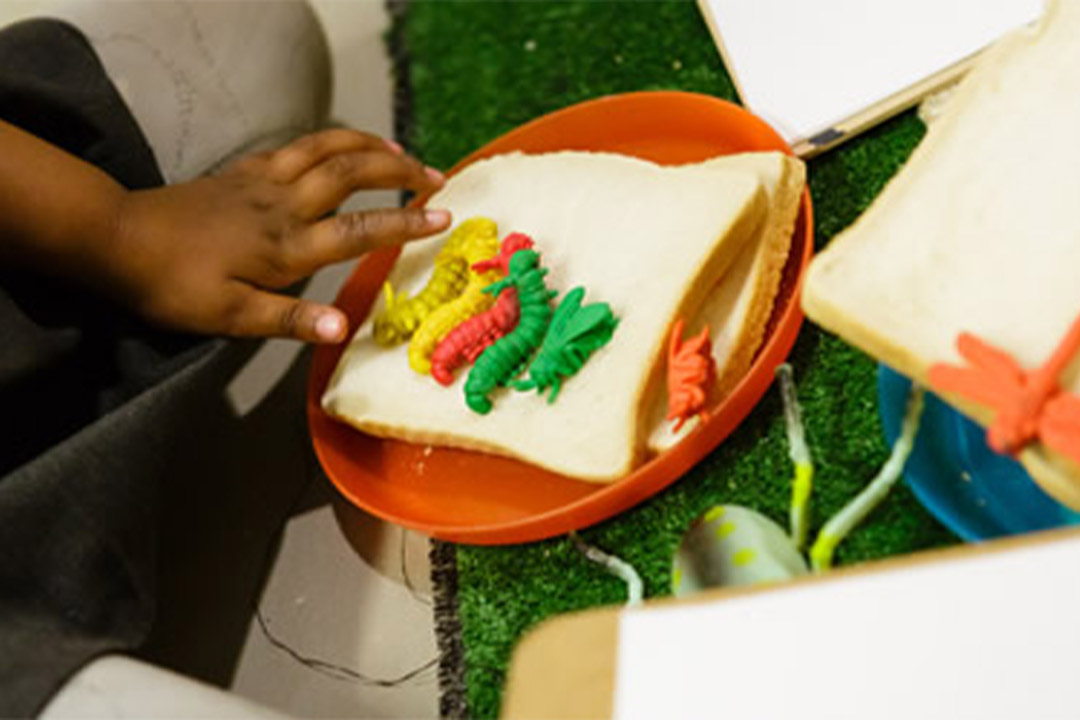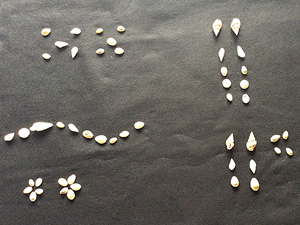Composition
Understanding that one number can be made up from (composed from) two or more smaller numbers

Knowing numbers are made up of two or more other smaller numbers involves ‘part–whole’ understanding. Learning to ‘see’ a whole number and its parts at the same time is a key development in children’s number understanding. Partitioning numbers into other numbers and putting them back together again underpins understanding of addition and subtraction as inverse operations.
Typical progression of key ideas in this concept
Children need opportunities to see small numbers within a larger collection. ‘Number talks’ allow children to discuss what they see. For instance, with giant ladybirds: ‘There are 5 spots altogether. I can see 4 and 1, I can see 3 and 2, and I can see 1 and 1 and 1 and 1 and 1.’
Encourage exploration of all the ways that ‘five’ can be and look. Children are encouraged to look closely at numbers to see what else they can see. This reinforces the concept of conservation.
Activities and opportunities:
- encouraging making arrangements with (e.g.) ten. Ensure the children talk about the different arrangements they can see within the whole

Children need opportunities to partition a number of things into two groups, and to recognise that those groups can be recombined to make the same total. Encourage children to say the whole number that the ‘parts’ make altogether.
Activities and opportunities:
- exploring songs; for example, ‘Five Currant Buns’ – show that the whole is still five, but some are in the shop and some have been taken away; check throughout that there are still five currant buns
- playing skittles and looking at how many are standing. How many have fallen over? How many are there altogether?
Children need opportunities to explore a range of ways to partition a whole number. The emphasis here is on identifying the pairs of numbers that make a total. Children can do this in two ways – physically separating a group, or constructing a group from two kinds of things.
Activities and opportunities:
- Numicon towers: layering up Numicon pieces of the same total
- putting things into two containers in different ways
- making a number with two different kinds of things. For example, make a fruit skewer with five pieces of fruit, using bowls of bananas/strawberries to choose from; then ask the children to describe how they have made theirs. They should compare it with a partner's: ‘What is the same about your skewers? What is different?’
- Bunny Ears: using your fingers like bunny ears. 'With two hands, show me five fingers. Can you do it in a different way?' Or, 'Show five fingers altogether with a friend'
- Spill the Beans: using double-sided counters or beans, where one side is coloured, throw the collection and note how many of each type can be seen and how many altogether
- using six bean bags with different fabric on each side, throw the collection and note how many of each type can be seen.
Children need opportunities to explore the different ways that numbers can be partitioned, i.e. into more than two groups. Situations to promote this include increasing the number of pots to put a given amount into, e.g. planting ten seeds into three or more pots.
Activities and opportunities:
- role play, e.g. in a toy shop, ten toys need arranging onto the three shelves. How will you organise them?
- having more than two places to sort things into in any given context, e.g. arranging characters in small-world play in different locations
- games such as ‘Posh Ducks’ (Griffiths, R., Back, J.& Gifford, S. (2016) Making Numbers: Using manipulatives to teach arithmetic OUP): using a set number of ducks, for example ten in three different locations (nest, water, decking), roll the dice and make one group match the amount shown without adding or taking any away.
Children need opportunities to say how many are hidden in a known number of things. For example: ‘Five toys go into a tent, then two come out. How many are left in the tent?’ The child should respond that there are still three toys in the tent.
Activities and opportunities:
- playing hiding games with a number of objects in a box, under a cloth, in a tent, in a cave, etc.
- utilising classroom routines such as tidy-up time to identify how many are still missing from a pot with a number label.
- children suggesting that a larger number than the total are hidden.
Can a child:
- subitise small groups within a larger number?
- make a reasonable guess at a hidden number?
- in context, state two groups that make a larger amount? For example, how might the (six) bean bags land? You could have three with stripes up and three with spots up.